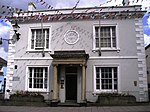Northavon

Northavon was a district in the English county of Avon from 1974 to 1996. The district was formed by the Local Government Act 1972 on 1 April 1974 as part of a reform of local authorities throughout England and Wales. Under the reorganisation, the area surrounding the cities of Bath and Bristol was formed into a new county of "Avon", named after the river that ran through the area. The county was divided into six districts, one of which was formed from the areas of Sodbury Rural District (except the parish of Alderley) and most of Thornbury Rural District (16 out of 21 parishes) in Gloucestershire. The name "Northavon" was invented in 1973, simply denoting the district's position in the county. In 1991 the county boundaries of Avon and Gloucestershire were realigned. The main effect of the change was that the Hillesley and Tresham area was transferred from Northavon to the neighbouring District of Stroud in Gloucestershire.Following a review by the Local Government Commission for England, both the County of Avon and District of Northavon were abolished on 1 April 1996. Northavon was merged with the neighbouring Borough of Kingswood to form the unitary authority of South Gloucestershire.Northavon was a parliamentary constituency. It was abolished ahead of the 2010 general election, with the area being split between the constituencies of Filton and Bradley Stoke and Thornbury and Yate.
Excerpt from the Wikipedia article Northavon (License: CC BY-SA 3.0, Authors, Images).Northavon
Avon Way,
Geographical coordinates (GPS) Address Nearby Places Show on map
Geographical coordinates (GPS)
| Latitude | Longitude |
|---|---|
| N 51.604 ° | E -2.518 ° |
Address
Avon Way 19
BS35 2DG
England, United Kingdom
Open on Google Maps







